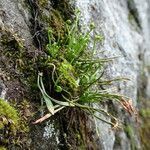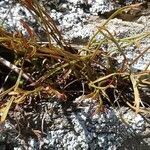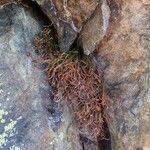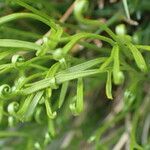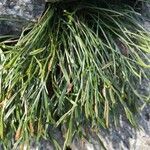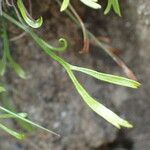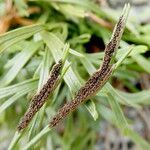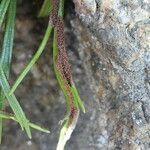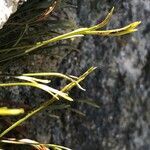Roots not proliferous. Stems erect, much branched to produce dense many-stemmed tufts or mats bearing numerous crowded leaves; scales dark reddish brown to black throughout, narrowly deltate, 2--4 × 0.3--0.6 mm, margins entire. Leaves monomorphic. Petiole dark reddish brown proximally, fading to green distally, 2--13 cm, 2--5 times length of blade; indument absent. Blade linear, simple or more often 1-pinnate, 0.5--4 × 0.1--0.4 cm, occasionally wider when pinnae strongly diverge, leathery, glabrous; base acute; apex acute, not rooting at tip. Rachis green, lustrous, glabrous. Pinnae of pinnate leaves 2(--4), strongly ascending to give forked appearance, linear, (5--)10--30 × 0.75--3 mm; base acute; margins remotely lacerate; apex acute. Veins free, obscure. Sori usually 2+ per pinna, parallel to margins. Spores 64 per sporangium. 2 n = 144.
Plants forming large, very dense tufts, with numerous, crowded, slender lvs 5–15 cm, grass-like in aspect; petiole greenish, very slender, ca 0.5 mm thick, ± erect, generally longer than the blade; blades irregularly forked, with a few narrow segments (or some unforked), each segment 1–2 cm × 1–2 mm, entire or with a few long, slender teeth (reduced pinnules), and with a single compound sorus (subtended by a ± continuous indusium just within the margin on each side) running its whole length; 2n=144. Interruptedly circumboreal, in Amer. mostly cordilleran, but disjunct on shale in Monroe and Hardy cos., W.Va.
A fern. It grows 8-15 cm tall. It has a short creeping rhizome or underground stem. It has dark brown narrowly triangle shaped scales. The leaves are crowded in tufts. They are slender and 5-15 cm long.
